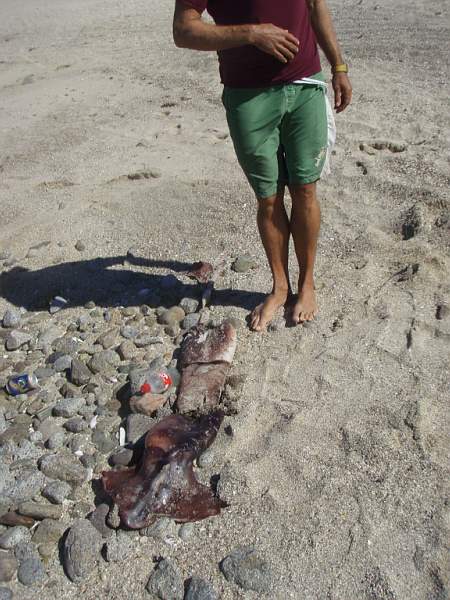Published in the Ocean Watch column, Honolulu Star-Advertiser © Susan Scott
April 13, 2009
Last week an “Ocean Watch” reader recognized me at the bank.
We chatted for a minute, and then he said, “Have you written about squid?”
Funny he should ask. I have written about squid, but since I found a 3-foot-long squid body on a Sea of Cortez beach, I have more to say about these weird and wonderful creatures.

My beached squid was brick red, freshly dead and cut widthwise in three equal pieces. Since the gulls had been busy recycling, the creature’s guts, eyes and arms were gone. One of its two tentacles, built for striking out and grabbing prey, remained.
In the sand, I reassembled the squid’s pieces and stretched out the tentacle, which was nearly as long as the body. Something big and sharp had cut the beefy body apart; the slashes were as clean as butcher-knife cuts and bore no teeth marks. I think the culprit was a ship’s propeller.
Even severed and nibbled, my find thrilled me. I was looking at my first Humboldt squid.
The Sea of Cortez is famous for hosting millions of Humboldt squid — population estimates are around 20 million — but this wasn’t always the case. Before the 1950s there were no Humboldt squid in this area.
These squid were named after the Humboldt Current, which runs along the west coast of South America. Humboldt squid once lived from Tierra del Fuego to Southern California, at depths of 600 to 2,300 feet. But these squids are expanding their range and are now found along the west coasts of Mexico and North America all the way to Sitka, Alaska.
No one knows why these formidable predators are going north, but researchers have two theories. One is that changing ocean temperatures are affecting the squid’s food sources.
Another conjecture is that the squid’s predators — sharks, billfish, tunas and other big fish — have been so overfished, the squid’s numbers are no longer in check.
My squid looked big to me, but it was a little guy. Humboldts grow to 6 feet long and can weigh 100 pounds. Like all squid, this species changes colors in an instant from deep purple to white.
Jumbo squid is another name for Humboldts. They’re also called jumbo flying squid because they can shoot themselves from the water and glide through the air to escape predators.
The Spanish name for the species is “diablo rojo,” red devil, a name reflecting this squid’s usual color and its fierce hunting technique. These squid have toothlike hooks on their suckers. When the tentacles pull in prey, the eight arms hold it against the mouth and turn it with the suckers like corn on the cob. A Humboldt can eat a whole hooked fish before the angler can reel it in.
At night Humboldt squid rise from the ocean depths to feed, hunting cooperatively in packs of up to 1,200 individuals. They eat anything they can catch, including each other. When researchers examined the stomach contents of 500 squid, 26 percent contained members of their own species.
The roving Humboldts of today might be boldly going where the species has never gone before, but most likely they are only adapting to human destruction of their natural world. We should thank these remarkable creatures for giving us the heads-up.
One of the best parts of marine biology is that there is no end of answers to no end of questions. Thanks for asking.